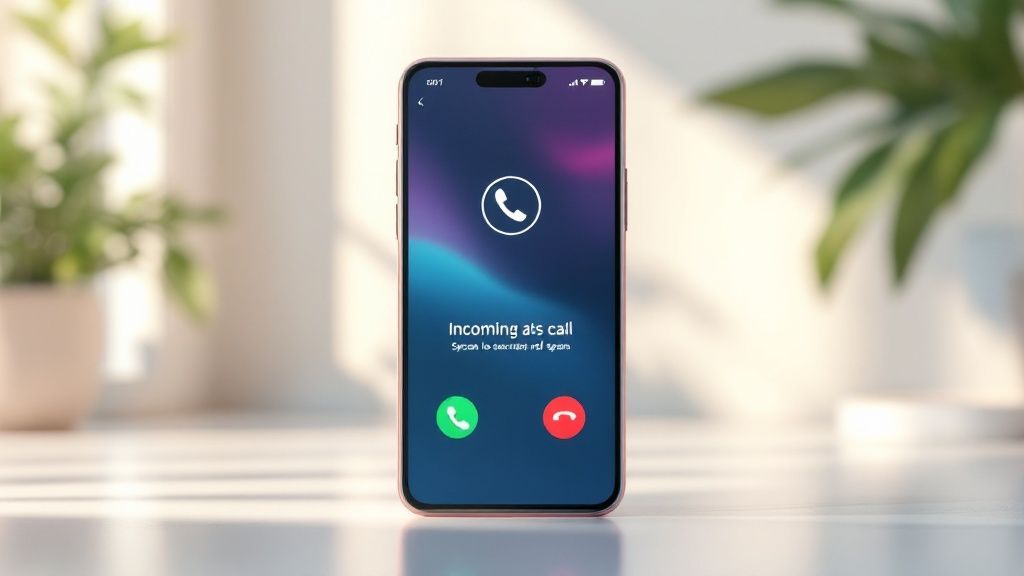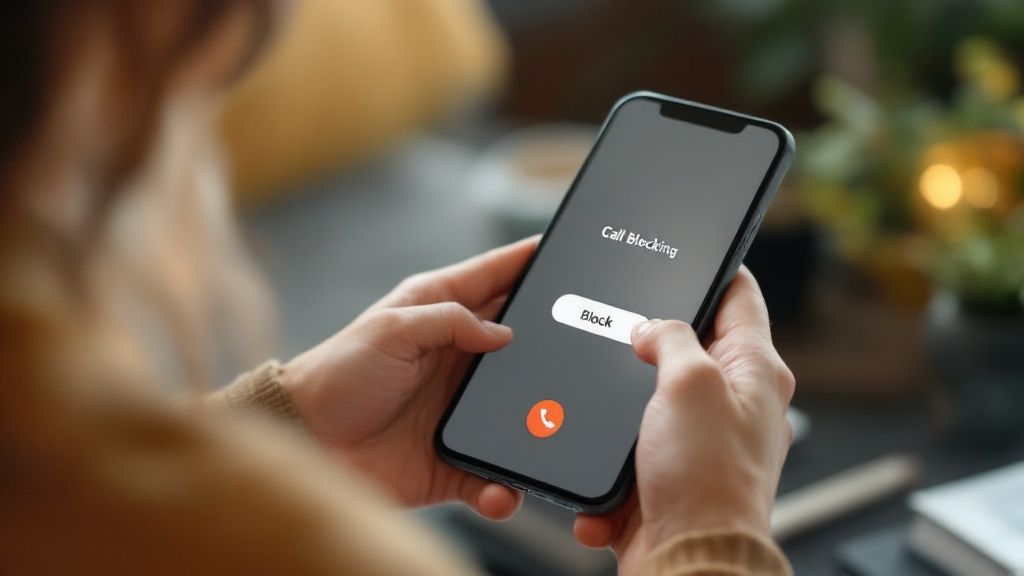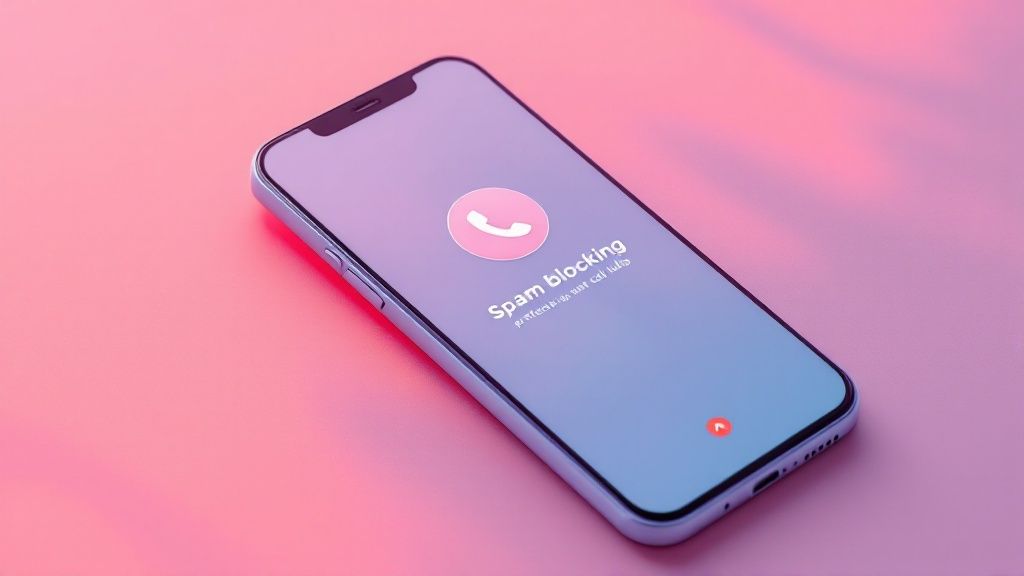The Rising Tide of Spam Calls: Understanding What You're Up Against

Before tackling the issue of unwanted calls, it's essential to understand why they happen. Learning the tactics spammers use and the reasons behind their persistence is key to protecting yourself. This knowledge will empower you to take proactive steps.
How Spammers Obtain Your Number
Spammers acquire your phone number through various methods. Sometimes, it's random dialing, a "spray and pray" approach. Often, they purchase lists from data brokers. Even seemingly harmless online competitions or surveys can inadvertently expose your number. This highlights the importance of carefully reviewing terms and conditions before sharing personal information online.
Why Spam Calls Are More Convincing
Spammers constantly refine their tactics, making their calls increasingly difficult to identify. They often use spoofing technology to mask their real number, making it appear as a local business or government agency. This is designed to lower your guard. Social engineering techniques are also employed, preying on vulnerabilities to trick you into divulging information or money.
Who Is Most at Risk?
While anyone can be a target, some groups are more vulnerable. Older Australians may be less familiar with current scam tactics and more trusting of authority figures. Newcomers to Australia or those unfamiliar with local regulations can also be easier targets for scammers impersonating officials. Vigilance and awareness are crucial defenses.
The Growing Problem of Spam in Australia
Australia's Scamwatch service provides valuable data on spam communication. In 2023, Australians filed over 301,700 reports with Scamwatch, the highest number recorded. Text message scams were particularly common, with 109,621 reports, a 37.3% increase from 2022. This rise correlates with increased phishing, including toll scams and government impersonations. You can find more detailed statistics in the Targeting Scams Report.
Knowing your "enemy" is the first step. By understanding the tactics and who is most vulnerable, you can start implementing effective protective strategies. This lays the groundwork for exploring practical solutions, from your phone's features to third-party apps, which we'll discuss next.
Unleashing Your Phone's Hidden Spam-Fighting Powers

Your smartphone, whether it's an iPhone or an Android, comes equipped with built-in features to help combat those pesky spam calls. These tools can significantly reduce unwanted interruptions and give you back control over your phone. Let's explore how to activate and use these powerful options.
Silencing the Unknowns: Blocking Features
Both iPhone and Android offer the ability to silence unknown callers. This feature sends calls from numbers not saved in your contacts directly to voicemail. This is particularly helpful for minimizing interruptions from telemarketers and potential scammers. However, keep in mind that you might miss calls from legitimate but unknown numbers, such as a doctor's office or a delivery driver.
On an iPhone, you can activate "Silence Unknown Callers" in the "Phone" settings. Android phones offer similar functionality, usually located within the call settings or sound and vibration options.
Creating Your Personal Block List
Both operating systems allow you to create and manage a personal block list. This provides a more targeted approach compared to silencing all unknown calls. As you identify spam numbers, add them to your blocked list.
Some phones even offer automatic blocking of suspected spam calls. This feature relies on algorithms to identify patterns commonly associated with spam. You can typically enable this in your phone's call settings.
Do Not Disturb: Setting Boundaries
Do Not Disturb mode, while not specifically designed for spam calls, can be a powerful tool when used strategically. You can customize Do Not Disturb to allow calls from specific contacts, like family or close friends, while silencing all others during certain times. This puts you back in control of your time without the worry of missing important calls.
Schedule uninterrupted time for work, family, or simply relaxing without being bombarded by spam. You can also utilize Do Not Disturb during specific events or meetings.
Testing Your Defenses: Is It Working?
After implementing these strategies, test their effectiveness. Have a friend or family member call from a number not in your contacts to verify that the "Silence Unknown Callers" feature and your personal block list are working correctly.
Regularly review and update your blocked list and Do Not Disturb settings to ensure they continue meeting your needs. These built-in features can significantly reduce spam calls, giving you greater peace of mind and more control over your phone. By understanding and utilizing these tools, you can take a proactive stance against unwanted calls. If you're still receiving a high volume of spam calls, consider exploring third-party apps.
Beyond Basic Blocking: Third-Party Apps That Actually Work

While your phone's built-in blocking features offer a first line of defense against spam, they often fall short. This is where third-party apps step in, providing extra protection and advanced features that can significantly reduce unwanted calls. Finding the right app for your needs in Australia can be tricky, so let's explore the options.
How Spam Call Blocking Apps Work
Different apps use various methods to identify and block spam. Some use crowdsourced databases, where users report spam numbers, building a shared list of offenders. Others use more sophisticated techniques, such as AI algorithms that analyze call patterns and flag suspicious activity. For example, an app might flag a call from an overseas number frequently reported as a scam.
Key Features to Look For
Look beyond simple blocking. Here are some key features to consider:
- Call Screening: This feature allows the app to answer calls from unknown numbers and request identification before connecting you.
- Suspicious Number Lookup: Quickly check if a number has been flagged as spam by other users.
- Automated Responses: Some apps can automatically respond to spam calls with a pre-recorded message, saving you time and deterring scammers.
Privacy Considerations: Protecting Your Data
Choosing a third-party app requires careful consideration of your privacy. Look for apps with transparent privacy policies that clearly outline how your data is used and protected. This is especially important given today’s data security concerns.
To help you make an informed decision, we've compiled a comparison of popular spam call blocking apps available in Australia. The table below highlights key features, effectiveness ratings, and pricing to help you choose the best fit for your needs.
Top Spam Call Blocking Apps Comparison: A comparison of popular spam call blocking applications available in Australia, highlighting key features, effectiveness ratings, and pricing.
| App Name | Key Features | Effectiveness Rating | Price | Privacy Rating |
|---|---|---|---|---|
| Hiya | Caller ID, spam blocking, call control | High | Free, Premium version available | Good |
| Truecaller | Caller ID, spam blocking, SMS blocking | High | Free, Premium version available | Moderate |
| Mr. Number | Spam call and text blocking, customizable blocking options | Medium | Free | Moderate |
As you can see, each app offers a unique blend of features and pricing options. Consider your priorities and preferences when selecting an app.
Optimizing App Settings for Maximum Effectiveness
Downloading an app is only the first step. To maximize its effectiveness, configure the settings to suit your individual needs. Enable features like automatic blocking of suspected spam and personalize your block list. Regularly updating the app ensures you have the latest spam definitions and features.
By carefully selecting an app with the right features and prioritizing privacy, you can significantly strengthen your defense against spam calls. Combined with your phone's built-in features, these strategies empower you to reclaim control over your phone and protect yourself from unwanted interruptions.
The Do Not Call Register: What It Really Does (And Doesn't) Stop

The Australian Do Not Call Register is a helpful tool for managing unwanted calls. It's important to understand its limitations so you can develop a comprehensive strategy for minimizing interruptions. This section clarifies what the Register can and cannot achieve.
Who Can Still Call You?
Registering your number on the Do Not Call Register doesn't block all unwanted calls. Certain organizations are exempt. Charities seeking donations, political parties conducting surveys, and research companies are still permitted to contact you.
Also, businesses with whom you have an existing relationship can still call. This includes companies you've recently made a purchase from. The Register primarily targets unsolicited telemarketing calls.
Timing Matters: When Protection Begins
Protection isn't immediate after registering. It takes up to 30 days for the registration to fully activate. You might still receive telemarketing calls during this period.
For instance, if a telemarketing campaign started before your registration was active, you could still receive calls from that particular campaign. Patience is key while the registration takes effect.
Registering Multiple Numbers and Checking Your Status
You can register both landline and mobile numbers on the Do Not Call Register through the ACMA website. The process is simple and allows you to register multiple numbers at once.
This is especially convenient for protecting your entire household. The ACMA website also lets you check the registration status of your numbers to ensure your protection is active.
What to Do When the Register Is Ignored
If you continue receiving telemarketing calls after the 30-day activation period, file a complaint with the ACMA. These complaints help enforce the rules against companies violating the regulations.
Australia is actively working to reduce spam calls. The National Anti-Scam Centre's 2024 report shows a 25.9% decrease in reported scam losses and a 17.8% reduction in scam reports in 2024. These statistics highlight ongoing efforts to combat scams and spam calls.
Maximizing Protection for Vulnerable Family Members
Help elderly family members or those less comfortable with technology register their numbers. This provides added protection against scams targeting vulnerable individuals. Educate them about the Register’s function and the importance of remaining vigilant.
The Do Not Call Register is a valuable tool, but it's not a complete solution on its own. Combining the Register with other strategies, like using your phone's blocking features, creates a more effective defense against unwanted calls.
How Your Telecom Provider Is Fighting Spam (And How to Help)
Your telecom provider is a key player in the fight against annoying spam calls. They're using various technologies and strategies to block these unwanted interruptions before they even ring your phone. Let's explore how these defenses work and how you can contribute to a spam-free experience.
Network-Level Defenses: Blocking at the Source
Major Australian providers like Telstra, Optus, and Vodafone are actively using network-level blocking systems. These systems analyze call patterns, flag suspicious activity, and block calls from known spam sources. This proactive approach stops millions of spam calls every day.
For instance, these systems can identify and block calls from numbers frequently reported as spam. They can also target numbers displaying unusual calling behavior, such as a massive volume of calls in a short period. This prevents these calls from ever disturbing you.
Opt-In Protection Programs: Enhanced Security
Many providers offer opt-in protection programs that provide another layer of defense. These programs often use advanced analytics and AI to identify and block spam calls more effectively. Enrolling in these programs can significantly reduce the amount of spam you receive.
While these programs might have a small monthly fee, they can offer significant benefits. Think less spam and more peace of mind. Check with your provider to explore the available options.
Carrier-Specific Codes and Reporting: Taking Action
Some providers offer carrier-specific codes to instantly block robocalls. You might be able to forward a spam call to a designated number to report it and automatically block future calls from that number.
Reporting suspicious calls directly to your provider is also crucial. This helps them improve their blocking systems and take action against repeat offenders. By reporting spam, you're helping build a stronger defense for everyone.
Industry Collaboration: A United Front Against Spam
Australian telecommunications companies are joining forces to combat spam calls. They share information about suspected spam numbers and collaborate on developing new blocking technologies. This teamwork creates a more comprehensive and effective defense system.
Telecommunications companies in Australia have already seen impressive results. The Australian Communications and Media Authority (ACMA) reported that telcos blocked over 225.5 million scam calls and over 79.4 million scam SMS messages in just one quarter of 2023. This number jumped to over 246.7 million blocked scam calls in the fourth quarter of 2023. Find more detailed statistics here. This shows the effectiveness of industry collaboration and technological advancements. However, the persistent high volume of scam calls underscores the ongoing need for vigilance and consumer education.
By working together and using technology, Australian telecom providers are making real progress in the fight against spam. By understanding these efforts and reporting suspicious calls, you can actively participate in strengthening this defense and protecting yourself from unwanted interruptions.
Psychology-Backed Techniques for Handling Persistent Callers
Technology like call blocking apps can be incredibly helpful in stopping spam, but some unwanted calls still get through. That's why understanding the psychology behind these calls is so important. Knowing how to handle persistent callers can drastically reduce future spam and help protect your personal information.
The Power of Silence: Why Less Is More
One of the best strategies is surprisingly simple: don't engage. Never confirm your name or any other personal details. Even a simple "yes" can be manipulated and used against you in certain scams. The less information you give out, the less useful you are to a spammer. Imagine it's a poker game – you don't want to show your cards.
Hanging Up: The Quickest Escape
The fastest and most effective way to deal with a spam call? Hang up immediately. There's no need to explain, argue, or get into a conversation. Hanging up sends a clear message that you're not interested and often discourages further calls. If you recognize a robocall or a telemarketer pitching something you don't need, just hang up.
Changing Your Phone Habits: Lowering Your Profile
Believe it or not, some phone habits, like answering calls from unknown numbers, can actually increase spam calls. By being more selective about the calls you answer, you can lower your targeting profile.
Handling Common Spam Scenarios: What to Say (and Not Say)
Understanding common sales tactics can help you anticipate and effectively respond to persistent callers. Resources like articles on B2B cold calling tips can offer valuable insights into these tactics. Here's how to handle specific situations:
-
Fake Bank Representatives: Never, ever give out your account details or passwords over the phone. If you're unsure about a call, hang up and contact your bank directly through their official channels.
-
Aggressive Telemarketers: A firm but polite "No, thank you" is usually enough. Avoid getting drawn into long conversations.
Red Flags That Indicate a Spam or Scam Call
Knowing the warning signs of a scam can help you quickly identify and avoid them. The table below summarizes common tactics used by spam callers.
To help you identify potentially fraudulent calls, take a look at these common warning signs:
| Warning Sign | What It Means | Recommended Response |
|---|---|---|
| High-pressure tactics | The caller is pushing you to act quickly without thinking | Hang up |
| Requests for personal information | Scammers try to steal your identity | Refuse to provide information and hang up |
| Promises of prizes or unrealistic offers | If it sounds too good to be true, it probably is | Hang up |
| Threats or intimidation | Scammers use fear to manipulate you | Hang up and report the call |
In short, be wary of any call that uses high-pressure tactics, requests personal information, makes unrealistic promises, or uses threats.
Helping Vulnerable Family Members: Developing Healthy Skepticism
Protecting vulnerable family members from scams involves education and empathy. Encourage them to be cautious of unfamiliar callers and report any suspicious activity without causing undue alarm.
By using these psychology-backed strategies, you can regain control over your phone interactions and significantly reduce the nuisance of spam calls. Remember, your actions play a vital role in protecting yourself from unwanted interruptions and potential scams.
Turning the Tables: How Reporting Spam Calls Creates Real Change
Reporting spam calls isn't just a helpful act; it's a crucial tool in the fight against phone scammers. Every report provides valuable data that assists authorities in tracking down these offenders, improving blocking systems, and developing more effective policies. This section will guide you through reporting spam calls in Australia and explain how your actions contribute to positive change.
Where and How to Report: Maximizing Your Impact
Knowing where to report different types of spam calls is essential. For suspected scams, contact Scamwatch, the Australian Competition and Consumer Commission's (ACCC) reporting platform. For unwanted telemarketing calls, report the number to the Do Not Call Register. Dealing with persistent spam callers can be frustrating. Understanding sales tactics, like those used in B2B calling, can help you anticipate and respond. You might find helpful strategies in articles about B2B cold calling tips. Also, report suspicious calls directly to your telecom provider. They have systems to investigate and block these numbers at the network level.
What Makes a Report Effective: The Details Matter
The more information you provide, the more valuable your report becomes. Include the date and time of the call, the number displayed on your caller ID, and a brief description of the call's content. If you experienced any financial loss or shared personal information, include those details as well. This information helps authorities build stronger cases against scammers.
From Reports to Results: How Your Actions Create Change
Your reports are vital in shutting down scam operations. The data collected from individual reports helps authorities identify patterns and track down scammers. This can result in substantial penalties and even the dismantling of major scam networks. For example, in one case, multiple reports about a fake tax refund scam allowed investigators to trace the calls and ultimately prosecute the perpetrators.
Shaping Policy and Technology: The Power of Collective Action
The combined data from public reporting also informs government policy and the development of new technological solutions. By reporting spam calls, you contribute to a broader effort that benefits everyone. This collective action drives improvements in spam detection and blocking technology.
Practical Templates and Realistic Expectations: Making Reporting Easy
To simplify the reporting process, consider using pre-formatted templates for lodging your complaints. These templates usually prompt you for essential information, ensuring you include all the necessary details. While resolution timeframes vary, remember that every report contributes to the overall effort.
Case Studies: Real-World Examples of Success
Examining successful enforcement actions highlights the real-world impact of reporting. Cases where individual reports led to significant penalties or the shutdown of scam networks offer concrete evidence of the power of collective action. These stories can encourage others to take action.
Reporting spam calls isn't passive. It's an active step toward creating a safer communication environment for yourself and others. By taking a few minutes to report these unwanted interruptions, you contribute to a collective effort that combats spam calls, protects consumers, and helps shape the future of telecommunications security. Ready to regain control of your phone? Try OnSilent, a smart voicemail and call management solution designed for peace of mind.

